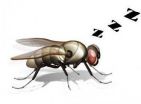(Press-News.org) PHILADELPHIA - Pulling an "all-nighter" before a big test is practically a rite of passage in college. Usually, it's no problem: You stay up all night, take the test, and then crash, rapidly catching up on lost sleep. But as we age, sleep patterns change, and our ability to recoup lost sleep diminishes.
Researchers at the Perelman School of Medicine, University of Pennsylvania, have been studying the molecular mechanisms underpinning sleep. Now they report that the pathways of aging and sleep intersect at the circuitry of a cellular stress response pathway, and that by tinkering with those connections, it may be possible to alter sleep patterns in the aged for the better – at least in fruit flies.
Nirinjini Naidoo, PhD, associate professor in the Center for Sleep and Circadian Neurobiology and the Division of Sleep Medicine, led the study with postdoctoral fellow Marishka Brown, PhD, which was published online before print in the journal Neurobiology of Aging.
Increasing age is well known to disrupt sleep patterns in all sorts of ways. Elderly people sleep at night less than their younger counterparts and also sleep less well. Older individuals also tend to nap more during the day. Naidoo's lab previously reported that aging is associated with increasing levels of protein unfolding, a hallmark of cellular stress called the "unfolded protein response."
Protein misfolding is also a characteristic of several age-related neurodegenerative diseases, such as Alzheimer's and Parkinson's diseases, and as it turns out, also associated with sleep deprivation. Naidoo and her team wanted to know if rescuing proper protein folding behavior might counter some of the detrimental sleep patterns in elderly individuals.
Using a video monitoring system to compare the sleep habits of "young" (9 days old) and "aged" (8 weeks old) fruit flies, they found that aged flies took longer to recover from sleep deprivation, slept less overall, and had their sleep more frequently interrupted compared to younger control animals. However, adding a molecule that promotes proper protein folding – a molecular "chaperone" called PBA -- mitigated many of those effects, effectively giving the flies a more youthful sleep pattern. PBA (sodium 4-phenylbutyrate) is a compound currently used to treat such protein-misfolding-based diseases as Parkinson's and cystic fibrosis.
The team also asked the converse question: Can protein misfolding induce altered sleep patterns in young animals. Another drug, tunicamycin, induces protein misfolding and stress, and when the team fed it to young flies, their sleep patterns shifted towards those of aged flies, with less sleep overall, more interrupted sleep at night, and longer recovery from sleep deprivation.
Molecular analysis of sleep-deprived and PBA-treated flies suggested that PBA acts through the unfolded protein response. PBA, Naidoo says, had two effects on aged flies: it "consolidated" baseline sleep, increasing the total amount of time slept and shifted recovery sleep, after sleep deprivation, to look more like that of a young fly.
"It rescued the sleep patterns in the older flies," she explains.
These results, Naidoo says, suggest three key messages. First, sleep loss leads to protein misfolding and cellular stress, and as we age, our ability to recover from that stress decreases. Second, aging and sleep apparently form a kind of negative "chicken-and-egg" feedback loop, in which sleep loss or sleep fragmentation lead to cellular stress, followed by neuronal dysfunction, and finally even poorer-quality sleep.
Sleep recharges neuronal batteries, Naidoo explains, and if a person is forced to stay awake, those batteries run down. Dwindling physiological resources must be devoted to the most critical cell functions, which do not necessarily include protein homeostasis. "Staying awake has a cost, and one of those costs is problems with protein folding."
Finally, and most importantly, she says these results suggest -- assuming they can be replicated in mice and humans – that it may be possible using drugs such as PBA to "fix sleep" in aged or mutant animals.
"People know that sleep deteriorates with aging," Naidoo says, "But this might be able to be stopped or reversed with molecular chaperones." Her team is now looking to determine if a similar situation exists in mammals and if better sleep translates into longer lifespan.
INFORMATION:
Additional authors from Penn include Marishka Brown, May Chan, John Zimmerman, Allan Pack, and Nicholas Jackson.
The study was funded by the National Heart, Lung and Blood Institute (NHLBI T32, HL0771, 3P01HL094307) and the National Institute on Aging (AG032500).
Penn Medicine is one of the world's leading academic medical centers, dedicated to the related missions of medical education, biomedical research, and excellence in patient care. Penn Medicine consists of the Raymond and Ruth Perelman School of Medicine at the University of Pennsylvania (founded in 1765 as the nation's first medical school) and the University of Pennsylvania Health System, which together form a $4.3 billion enterprise.
The Perelman School of Medicine has been ranked among the top five medical schools in the United States for the past 16 years, according to U.S. News & World Report's survey of research-oriented medical schools. The School is consistently among the nation's top recipients of funding from the National Institutes of Health, with $398 million awarded in the 2012 fiscal year.
The University of Pennsylvania Health System's patient care facilities include: The Hospital of the University of Pennsylvania -- recognized as one of the nation's top "Honor Roll" hospitals by U.S. News & World Report; Penn Presbyterian Medical Center; Chester County Hospital; Penn Wissahickon Hospice; and Pennsylvania Hospital -- the nation's first hospital, founded in 1751. Additional affiliated inpatient care facilities and services throughout the Philadelphia region include Chestnut Hill Hospital and Good Shepherd Penn Partners, a partnership between Good Shepherd Rehabilitation Network and Penn Medicine.
Penn Medicine is committed to improving lives and health through a variety of community-based programs and activities. In fiscal year 2012, Penn Medicine provided $827 million to benefit our community.
Study in fruitflies strengthens connection among protein misfolding, sleep loss, and age
2014-02-20
ELSE PRESS RELEASES FROM THIS DATE:
Enhancement of chemotherapy by prevention of tumor cell repair
2014-02-20
This news release is available in French. Chemotherapies are cancer treatments that work by inducing lesions in the DNA of tumour cells in order to inhibit their proliferation. However, the body naturally tries to repair these lesions, and thus reduces the efficacy of chemotherapy. Blocking the mechanisms for DNA repair would help to potentiate chemotherapy by reducing the resistance of cells to treatment. A team of researchers directed by Frédéric Coin, Inserm Research Director at the Institute of Genetics and Molecular and Cellular Biology (IGBMC) in Strasbourg (a ...
Zebrafish discovery may shed light on human kidney function
2014-02-20
ROCHESTER, Minn. — Feb. 20, 2014 — Researchers say the discovery of how sodium ions pass through the gill of a zebrafish may be a clue to understanding a key function in the human kidney. The findings from a collaboration between Mayo Clinic and the Tokyo Institute of Technology appear in the online issue of the American Journal of Physiology-Regulatory, Integrative and Comparative Physiology.
The researchers discovered a protein responsible for gas exchanges in the fish gill structure. Specifically they studied and characterized the Na+/H+ (sodium/hydrogen) exchanger ...
Multilevel approach to coping with stigmas identified
2014-02-20
Socially stigmatized groups have poorer health than non-stigmatized groups, but a team of researchers believes that more emphasis on two-way and multidisciplinary interventions will have a greater and more successful impact on relieving many health issues.
"We took an interdisciplinary approach to understanding how to reduce health disparities due to the effects of social stigma, including stigmas based on race, sexual orientation and chronic illness," said Jonathan Cook, assistant professor of psychology, Penn State.
Stigma results when a negative stereotype becomes ...
NASA's TRMM satellite saw extreme rainfall from Tropical Cyclone Guito
2014-02-20
VIDEO:
This animation of rainfall gathered from Feb. 11-19, 2014, by NASA's TRMM satellite revealed that Tropical Cyclone Guito produced as much as 16.9 inches/430 mm of rainfall in the center...
Click here for more information.
Tropical Cyclone Guito has been a powerful rainmaker, and fortunately, data from NASA's TRMM satellite shows that the heaviest rainfall has occurred over the open waters of the Mozambique Channel and not over land.
The Tropical Rainfall Measuring Mission ...
Dismantling pancreas cancer's armor
2014-02-20
SEATTLE – Pancreas cancer is notoriously impervious to treatment and resists both chemotherapy and radiotherapy. It has also been thought to provide few targets for immune cells, allowing tumors to grow unchecked. But new research from Fred Hutchinson Cancer Research Center shows that pancreas cancer "veils" itself from the immune system by recruiting specialized immune suppressor cells. The research team also found that removing these cells quickly triggers a spontaneous anti-tumor immune response.
The findings, published Feb. 20 in Gut, give hope for future immunotherapy ...
Clinical opinion published on use of maternal oxygen during labor
2014-02-20
When a fetal heartbeat pattern becomes irregular during labor, many practitioners give oxygen to the mother. But questions remain whether this oxygen supplementation benefits the fetus or may actually be potentially harmful.
A clinical opinion written by third year resident Maureen Hamel, MD, along with maternal-fetal medicine specialists Brenna Anderson, MD and Dwight Rouse, MD, of the Department of Obstetrics and Gynecology at Women & Infants Hospital of Rhode Island and The Warren Alpert Medical School of Brown University, has been published in the January 10, 2014 ...
Human and dog brains both have dedicated 'voice areas'
2014-02-20
The first study to compare brain function between humans and any nonprimate animal shows that dogs have dedicated voice areas in their brains, just as people do. Dog brains, like those of people, are also sensitive to acoustic cues of emotion, according to a study in the Cell Press journal Current Biology on February 20.
The findings suggest that voice areas evolved at least 100 million years ago, the age of the last common ancestor of humans and dogs, the researchers say. It also offers new insight into humans' unique connection with our best friends in the animal kingdom ...
Neuron-generating brain region could hold promise for neurodegenerative therapies
2014-02-20
Adult humans continuously produce new neurons in the striatum, a brain region involved in motor control and cognitive functions, and these neurons could play an important role in recovery from stroke and possibly finding new treatments for neurodegenerative disorders, according to a study published by Cell Press February 20th in the journal Cell. To detect the birth of new neurons in the striatum, the authors used a method that measures carbon-14 found in human DNA as a result of above-ground nuclear testing more than half a century ago. The findings reveal a surprise finding ...
Researchers regenerate sound-sensing cells in the ears of mice with hearing damage
2014-02-20
One of the major causes of hearing loss in mammals is damage to the sound-sensing hair cells in the inner ear. For years, scientists have thought that these cells are not replaced once they're lost, but new research appearing online February 20 in the journal Stem Cell Reports reveals that supporting cells in the ear can turn into hair cells in newborn mice. If the findings can be applied to older animals, they may lead to ways to help stimulate cell replacement in adults and to the design of new treatment strategies for people suffering from deafness due to hair cell loss.
Whereas ...
Mauritius kestrels show long-term legacy of man-made habitat change
2014-02-20
The widespread loss of forest to sugarcane fields on the island of Mauritius has forced kestrels living there to survive by speeding up their life histories, according to a report published online on February 20 in the Cell Press journal Current Biology. By getting an earlier start, the birds are managing to have just as many offspring, even though they die sooner.
Those changes to the kestrels' life history are apparently driven entirely by their early life experiences, the researchers say.
"This adaptive, plastic response is a testament to how resilient this species ...




